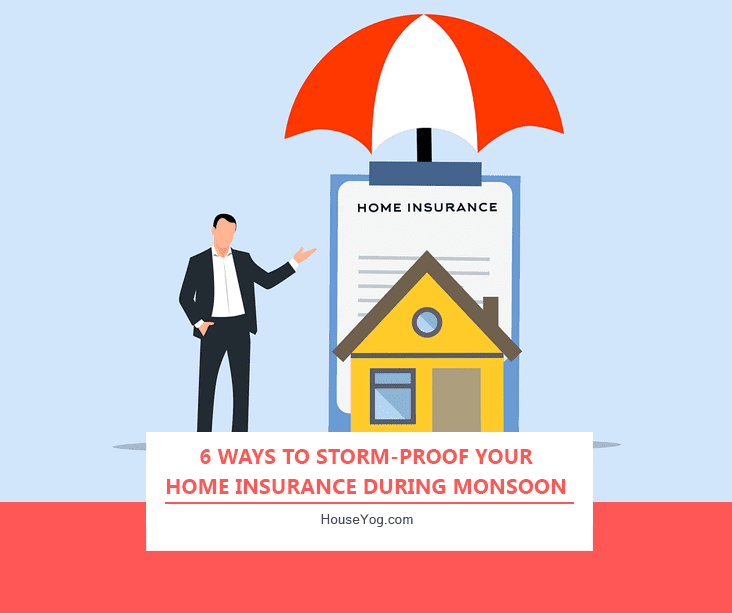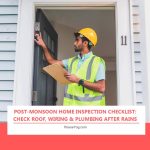The monsoon season brings much-needed relief from the summer heat — but it also brings challenges like water seepage, electrical short circuits, and even structural damage. While securing your home physically is important, having the right home insurance coverage is equally crucial.
Not all home insurance plans automatically cover storm or flood-related damages, which is why reviewing and updating your policy before the rains arrive makes all the difference.
Here are six smart and practical ways to storm-proof your home insurance and stay worry-free during the monsoon.
Make Your Home Insurance Monsoon-Proof in 6 Simple Ways
Monsoon damage can be unpredictable, but your insurance coverage doesn’t have to be. Below are six practical ways to strengthen your home insurance and reduce claim-related stress during stormy weather
1. Review the Scope of Coverage Before the Rains Begin
It’s easy to assume your existing home insurance policy covers everything. But storm damage, especially caused by floods or lightning strikes, often comes with exclusions or limited coverage.
What to check:
- Does the policy include protection against storms, floods, and water ingress?
- Are external fixtures (e.g., solar panels, fences, gates) covered?
- What is the limit for content damage due to water or electrical issues?
If you’re unsure about your home insurance coverage, ask your insurer for a review. It’s better to upgrade now than risk gaps later. Check for exclusions; many plans don’t cover seepage or mould.
Also, review your content cover. For instance, Digit Insurance offers built-in general contents cover as part of their home insurance plans. This means your essential household belongings are protected automatically, without requiring a separate add-on.
If you’ve added new electronics or furniture, your existing sum insured may fall short. Adjusting limits in advance ensures full protection during the monsoon.
2. Add Riders for Specific Monsoon-Related Risks
Many insurers offer optional add-ons or riders that can be included in your home insurance for a small additional cost. These can provide cover for high-value items or monsoon-specific threats.
Useful riders include:
- Electrical and mechanical breakdown (ideal during short circuits from power surges)
- Portable electronics cover
- Extended coverage for flooding in basement areas
- Alternate accommodation expenses if your home becomes uninhabitable
3. Document the Condition of Your Home and Belongings
Photographic or video evidence of your home’s condition before the monsoon is
essential. In the event of a claim, it helps prove that damage was caused by the storm and not due to pre-existing conditions.
Checklist for documentation:
- Take photos of walls, ceilings, and external roofing
- Photograph electronics, appliances, and expensive furnishings
- Save all purchase receipts and store digital backups
This small step can boost your claim’s success, speed up approvals, and lower the risk of rejection. Insurers value clear, well-documented evidence when assessing monsoon-related damages. It shows preparedness and builds trust during evaluation.
4. Check Claim Process and Emergency Response Times
Even a good home insurance policy is only as effective as the insurer’s claim process. When disaster strikes, you don’t want to be stuck in long call queues or wondering how to initiate a claim.
Questions to ask:
- Is there a 24×7 helpline for emergencies?
- How quickly does the insurer dispatch surveyors or agents?
- What is the average claim settlement time
Choose insurers known for prompt responses and seamless digital claims, especially during the monsoon season when requests surge. A faster, tech-enabled process can make all the difference when you need support urgently.
5. Secure Your Home, Because Prevention Still Matters
Your insurer may cover damages, but they’ll also expect that you’ve taken reasonable steps to protect your property. Neglect or lack of maintenance can lead to disputes or even claim rejections.
Monsoon readiness tips:
- Seal wall cracks and roof leaks
- Clean out rainwater gutters and drainage systems
- Install surge protectors for electronics
- Elevate wiring and appliances in ground-floor or basement areas
Some insurers may offer premium discounts if your home has storm shutters, drainage pumps, or smart monitoring systems. These upgrades show proactive risk management, which insurers value during high-risk seasons like the monsoon.
Before the next storm hits, make sure your property is in top shape. Check out our seasonal home maintenance checklist for Indian homes to keep your roof, walls, and drainage ready for monsoon challenges.
6. Understand the Fine Print on Exclusions and Deductibles
Most people don’t read their policy document until it’s time to claim, and by then, it’s too late. Knowing your exclusions and deductibles helps set realistic expectations and avoid future shocks.
Key things to note:
- Damage from negligence (e.g., leaving windows open during heavy rain) may not be covered
- Certain natural disasters, like landslides, may require special clauses
- The deductible is the amount you pay before your insurer contributes. Make sure
- You’re aware of this figure
Understanding your home insurance in full detail helps you avoid surprises, clarify
exclusions, and ensure adequate protection before and after a storm. Being informed means you can take timely action, file stronger claims, and recover faster from any damage.
A well-optimised home insurance policy cushions the impact of storm damage and also helps you recover faster, with less out-of-pocket expense.
Start by reviewing your coverage, adding necessary riders, and documenting your home’s condition. Don’t wait until it’s too late. Because when the winds rise and the rain falls, a strong insurance plan isn’t just a safety net, it’s peace of mind.
Conclusion: Prepare Today, Stay Protected Tomorrow
Monsoon season can be unpredictable, but your preparedness doesn’t have to be. By storm-proofing your home insurance and taking preventive steps, you safeguard not just your property but also your peace of mind.
Review your policy, understand the exclusions, and stay proactive about home maintenance. A few thoughtful upgrades and timely coverage reviews can go a long way in protecting your home against monsoon-related risks.
Whether you live in a metro or a flood-prone region, the right home insurance for monsoon season ensures that your recovery after any storm is quick, smooth, and stress-free.






